全文HTML
--> --> -->
根据加速器内气体初始状态的不同, 同轴枪放电等离子体的加速模式可分为预填充与爆燃两种. 如果放电前加速器内为一定气压的空气或抽至高真空后再充入一定量的其他工质, 气体击穿后所形成的等离子体薄层(等离子体片, plasma sheet)会沿轴向加速, 并在运动过程中不断碰撞电离前方的中性气体, 就像雪犁扫雪的过程一样, 因此该加速模式也被称为雪犁模式或预填充模式[13,14]; 而爆燃模式的实现则需要快速气阀的配合, 当加速器内被抽至高真空环境(10–3 Pa以上)后, 在充气的瞬间近乎同时开启主回路放电, 此时的工质大多集中在注气口附近, 还来不及向其他高真空区域扩散, 被击穿后所产生的等离子体会快速向前传播直至呈弥散状分布于整个枪内, 就像爆燃时燃烧波的传播过程一样, 因此该加速模式也被称为爆燃模式[4,15]. 与预填充模式相比, 由于放电前加速器内气体仍处于分布极度不均匀的状态, 在放电过程中除洛伦兹力外, 等离子体还会受到喷口外负压力的影响, 同时在其前进过程中也几乎没有中性气体供其电离, 因此在爆燃模式下所产生的等离子体速度更高, 但密度却相对要低得多. 并且对于爆燃模式而言, 喷出等离子体的特性会受到放电前枪内气体分布的显著影响, 而气体分布又会同时受到快速气阀数量、位置、充气时间、与放电间隔时间等多种因素的限制, 对装置设计的技术难度及可控性的要求上要高得多, 因此, 目前的同轴枪放电等离子体加速器仍旧以预填充模式为主.
如前文所述, 在同轴枪强流脉冲放电的研究中, 所产生等离子体的速度、电子密度、温度、能量密度等均是非常重要的衡量指标, 针对于不同的应用方向, 会对某一个或几个等离子体参数提出一定的要求, 而除加速模式外, 了解如何通过改变几何结构、放电参数、气动参数等来实现等离子体的参数调控及优化也是十分关键且必要的. 例如, 斯坦福大学的Cheng[15]将同轴枪的外电极改为圆锥形, 使得放电所产生等离子体的速度以及聚集程度都得到提高; Witherspoon等[16]将同轴枪内电极改为波浪形, 减弱了由磁场梯度引起的等离子体不稳定性; 美国加州的Hart[17]通过改变同轴枪内电极半径发现, 当内电极半径较小时更有利于产生高速冲击波, 且在高密度气体中效果更为显著; 为了方便地观察等离子体在枪内的时空演化过程, 布宜诺斯艾利斯大学的Milanese等[18]将同轴枪外电极结构改为鼠笼型, 发现了当电源提供的能量不足以完全电离被电流片扫过的中性气体时, 等离子体片将呈现出细丝状; 美国天主教大学的Lie等[19]发现, 当内电极长于外电极时, 可阻止等离子体焦点的形成. 美国NASA的Michels和Ramins[20]通过比较氩气、氮气和氢气三种不同的工作气体, 得出工作气体为氩气时能量利用效率最高, 氢气的能量利用效率最低. 为了抑制同轴枪放电中的等离子体分团现象, 大连理工大学的张俊龙等[21]研究了电容、电容充电电压以及工作气压的改变对等离子体团分离的影响.
通过追溯过往的工作我们可以发现, 研究者们的焦点多集中于如何获得高温度、高速度、高电子密度的等离子体, 以及如何提高同轴枪放电的能量利用效率[15,20,22], 但对所产生等离子体准直性的研究却相对较少. 事实上, 在等离子体惯性约束聚变以及磁约束聚变中的燃料注入等实际应用中, 提高喷射等离子体的准直性同样至关重要. 例如, 在等离子体射流驱动的磁化惯性约束聚变[23] (plasma jet driven magneto-inertial fusion, PJMIF)的实现方案中, 最高需要60束等离子体射流同时向中心会聚压缩磁化靶来实现聚变点火, 这就对每一路等离子体射流的准直性提出了严苛的要求.
本文通过长短两种外电极的比较, 研究了同轴枪外电极长度对等离子体特性的影响. 利用光电探测器、光谱仪和高速摄像机等设备对等离子体的光电特性及输运过程中的形态变化进行了诊断与分析, 同时测量并评估了喷射等离子体的扩散角及其准直性, 并最终给出外电极长度对同轴枪放电等离子体特性的影响规律.
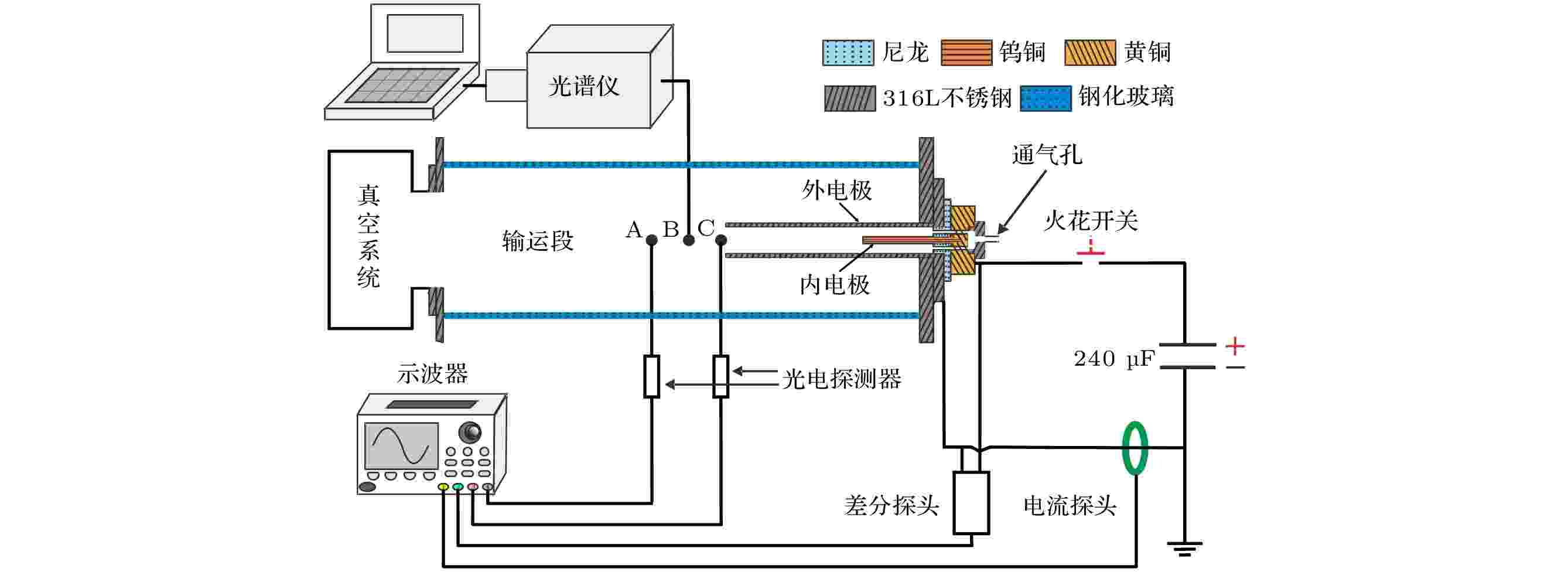 图 1 实验装置图
图 1 实验装置图Figure1. Schematic diagram of experimental equipment.
实验中采用的诊断工具主要包括光电探测器(Thorlabs PDA-10A)、光谱仪(Acton Spectrapro 2500i)、差分探头以及Pearson电流探头. Pearson电流探头主要用于测量回路电流, 差分探头用于采集电极两端的电压信号. 两路光电探测器、电流探头以及差分探头分别与数字示波器(Tektronix DPO 4104)的四个通道相连. 光电探测器内主要由光电二极管以及阻抗放大器构成, 光信号被收集后再通过光电转换及信号放大输出, 则能够观察到从枪中喷出等离子体的形态变化. 由于两路光电探测器的间距d为固定值, 计算两路光电流波形上升沿的时间差Δt后即可求得喷射等离子体的运动速度(图2). 实验中光谱仪的光栅设置为2400 line/mm, 由于整个放电过程仅为~100 μs量级, 在手动触发的情况下, 将光谱仪的曝光时间设定为3.0 s以采集完整的等离子体发射光谱, 再利用Hβ谱线(486.1 nm)的Stark展宽拟合, 可求得等离子体的电子密度, 其相应表达式为[25]
 图 2 不同长度外电极同轴枪在充电电压为5 kV, 气压为10 Pa放电条件下的电压、电流以及光电流波形 (a) 短外电极; (b) 长外电极
图 2 不同长度外电极同轴枪在充电电压为5 kV, 气压为10 Pa放电条件下的电压、电流以及光电流波形 (a) 短外电极; (b) 长外电极Figure2. Typical electrical and optical signals of discharge in a coaxial gun with (a) short and (b) long external electrode. V = 5 kV and P = 10 Pa.

为避免采集过多的杂散光以影响测量精度, 两路光电探测器(A和C)与光谱仪(B)的前端均配有光纤准直器(Thorlabs PDA-10A, 扩张角为0.027o)进行收敛准直, 该准直器保持水平放置并与同轴电极的轴线等高垂直, A, B, C三点与枪口的距离分别为125 mm, 75 mm和25 mm.
3.1.同轴枪放电特性
图2所示为不同外电极长度下的典型电压、电流及光电流波形. 闭合气体开关后, 同轴电极间电压会在几个μs内迅速上升并在~50 μs后发生气体击穿, 所形成的等离子体则与同轴电极以及外回路一起构成了完整的闭合回路, 根据Hart的雪犁模型[13,17], 该回路可等效为由电容、外回路电感与电阻以及同轴电极电感与等离子体电阻组成的RLC振荡回路, 因此电流信号表现为周期性衰减的正弦波形. 与外回路部分相比, 同轴电极电感与等离子体电阻本就相对较小, 所以从图2中几乎无法发现由外电极长度所带来电流波形的变化. 而击穿后同轴电极两端的电压U与电流I的关系则可表示为与电压和电流波形不同, 光电流信号在不同长度外电极同轴枪放电中却体现出了明显的差异: 1) 等离子体形态的变化; 无论是在短或长外电极中, 在半周期内都有且仅有一团等离子体喷出, 且该等离子体团均表现出了一定的厚度, 这与雪犁模式中关于等离子体薄层的假设明显不符, 很可能是由脱离外电极几何约束后等离子体的高密度梯度及快速热膨胀所导致; 2) C点的光电流信号幅值要大于A点, 这主要有以下两方面原因: 一方面, 在喷出枪口后, 等离子体将不再获能, 但在其前进的过程中仍旧会继续电离中性气体, 此时等离子体的复合率会逐渐上升并超过电离率, 因此其发光强度下降; 另一方面, 从同轴枪中喷出的等离子体具有很高的电子密度与温度, 快速的径向扩散导致单位面积的光信号强度减弱, 经准直器进入光电探测器的光子数减少, 从而使得电流信号强度减弱; 3) 正半周期的光电流信号幅值要大于负半周期, 除受到电流波形周期性衰减的影响外, 两次放电过程中同轴枪内的气体浓度与分布的差别也是一个重要的影响因素, 正半周期的光电流信号主要对应于一次放电, 放电前工质已均匀分布于同轴枪内, 气体击穿后所形成的等离子体片会碰撞电离前方的中性气体并通过静电拖拽推动其一起沿轴向传播, 但与理想的雪犁模型不同, 等离子体片不可能完全电离枪内的全部工质, 而是不可避免地存在中性气体的渗漏, 针对于氩气而言, 粒子从等离子体电流层中的高透过率是引起渗漏的主要原因[27], 此时枪内工质的分布已不再均匀, 同时其浓度相较于一次放电前出现大幅下降, 所以在衰减的反向电流作用下负半周期的光电流信号明显更弱; 4) 短外电极同轴枪放电的光电流信号幅值要大于长外电极; 外电极的延长, 会提高等离子体与电极壁面的碰撞复合损失, 这在大长径比的情况下会表现的尤其明显, 而来到负半周期, 放电前的工质浓度更低, 受到壁面复合损失的影响更大, 所以我们只能观察到微弱的光电流起伏.
2
3.2.等离子体速度
图3为不同长度外电极中等离子体速度随充电电压的变化. 无论在短或长外电极同轴枪中, 等离子体的速度均会随充电电压的增加而增加. 而对比不同外电极长度下的等离子体速度后发现, 在相同的充电电压下, 长外电极同轴枪放电中等离子体的速度总是高于短外电极, 其平均速度可以达到后者的1.5倍以上. 而在枪内放电与气动参数相同的情况下, 由外电极延长所带来的几何约束以及未可知的电磁加速机制则很可能是影响等离子体速度的关键因素.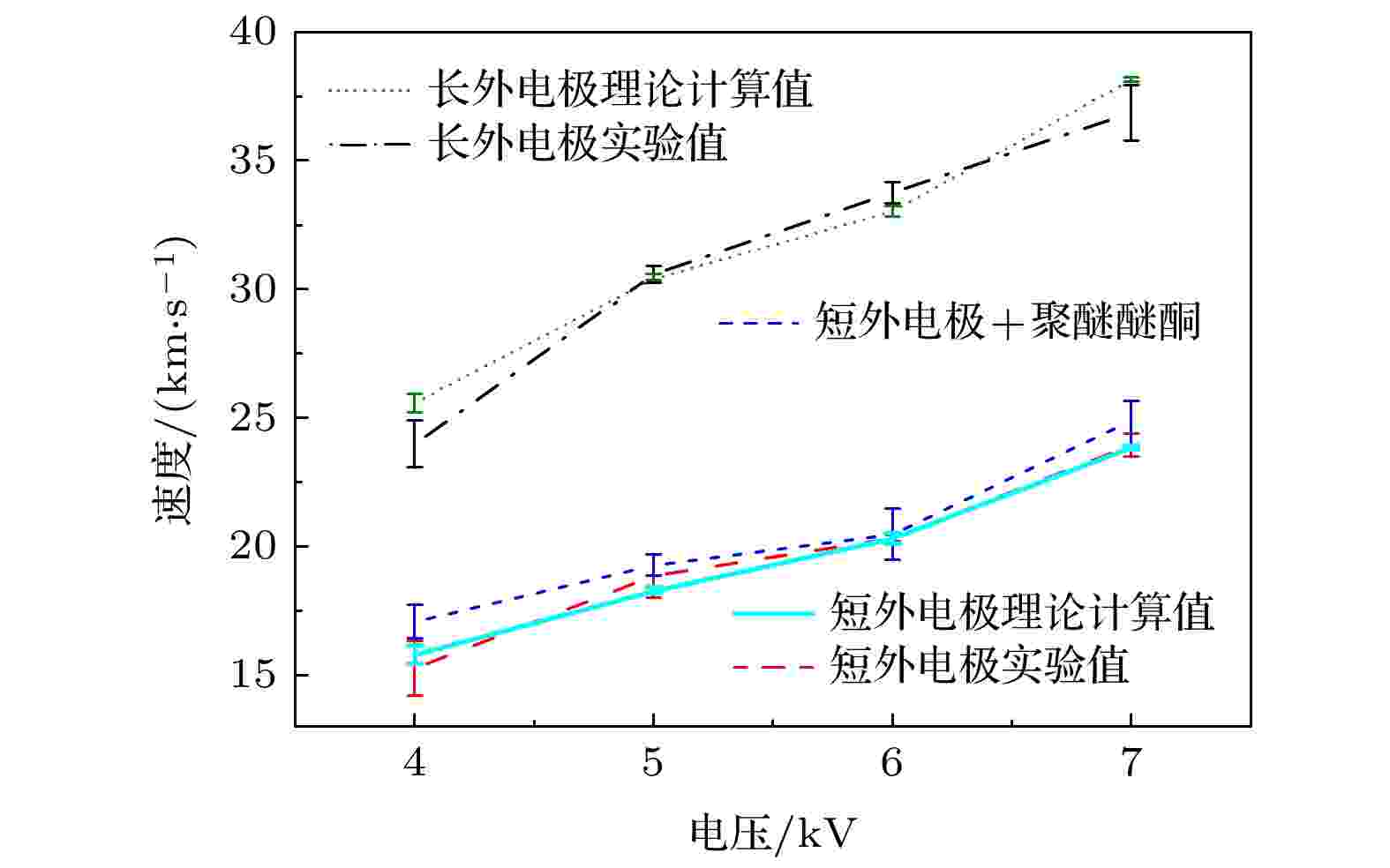 图 3 气压10 Pa时, 同轴枪放电等离子体速度随充电电压的变化
图 3 气压10 Pa时, 同轴枪放电等离子体速度随充电电压的变化Figure3. The variation of plasma velocity with the charging voltage of the coaxial gun at 10 Pa.
为单独验证几何约束对等离子体速度的影响, 选取了耐高温、耐烧蚀、低摩擦系数的聚醚醚酮绝缘材料, 将其加工为长30 mm、内外径与外电极相同的圆筒, 并通过螺纹连接放置于短外电极前端以阻断之后的主放电回路, 最后在绝缘圆筒前再接入270 mm的不锈钢圆筒以匹配长外电极的长度. 如图3所示, 与长外电极相比, 短外电极与聚醚醚酮材料的组合虽然长度不变, 但在放电过程中对等离子体速度的增幅却极为有限, 由此可知, 外电极延长所带来的几何约束虽然有利于等离子体速度的提高, 但却绝非是引起其1.5倍变化的主要原因.
若忽略壁面摩擦的影响, 则根据雪犁模型的假设, 同轴电极内中性气体的动能全部来源于等离子体片在枪内加速过程中所受的磁压[28], 由动量方程可得






2
3.3.等离子体柱
为进一步明确不同长度外电极同轴枪中的加速过程, 利用高速相机拍摄了等离子体喷出后的时空演化过程. 由于未设置同步触发, 因此在图4中将等离子体出现的第一张图像与光电流信号C的第一个上升沿起始点时间对应, 高速相机的采样率设为2 × 105 frame/s, 即每隔5 μs拍摄一张图像, 对于总时长为~100 μs的放电过程而言, 其误差不影响结果的定性分析. 如图4所示, 在10 μs时, 短外电极中的等离子体第一次喷出枪口, 并沿轴向向前传播. 直至60 μs时, 二次放电所产生的等离子体出现, 此时两团等离子体同时存在于输运段内, 由于一次放电等离子体在喷出后会继续电离前方的中性气体, 使得其运动路径上出现一条中性气体密度较低的高真空通道, 从而大幅降低了二次放电等离子体在输运过程中的速度衰减, 导致两团等离子体在90 μs时最终汇合. 而与长外电极中的结果对比后可以发现, 无论是长短外电极放电时光强的差异, 还是两次放电的时间间隔, 均与图2中的光电流信号完全一致. 此外, 从20 μs开始, 短外电极同轴枪的枪口位置处会出现一道亮柱, 该亮柱始终附着于枪口, 不随前方等离子体的运动而运动, 但其发光强度却会随着放电电流波形的变化而变化直至最后消失, 这说明该亮柱在放电过程中始终与主回路相连, 应为温度、电子密度都明显更高的等离子体所构成. 而在长外电极同轴枪中, 虽然无论是亮柱的尺寸、发光强度还是存在时间都有着减小/减弱的趋势, 但其变化规律却与短外电极时的情况无二. 分析后认为, 该等离子体柱很可能是由放电时部分聚集在内电极头部的等离子体发生箍缩效应后所形成[29,30], 而影响等离子体速度的电磁加速机制, 则是因为等离子体柱在枪内等离子体片运动过程中起到延长中心电极的作用进而导致加速时间的增加以及等离子体速度的提高.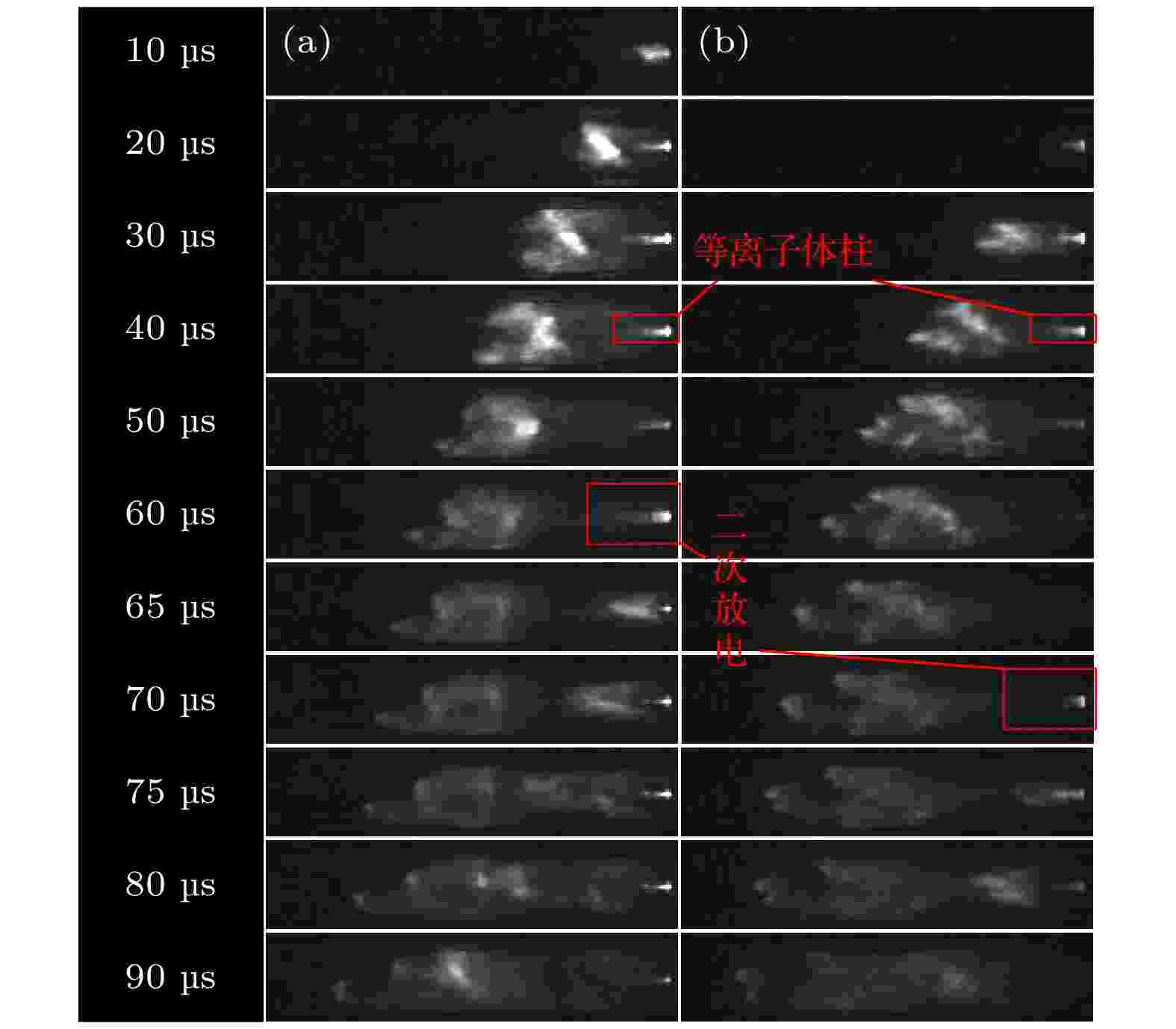 图 4 高速相机拍摄的同轴枪放电等离子体图像, 充电电压5 kV, 气压10 Pa, 曝光时间为5 μs (a) 短外电极; (b) 长外电极
图 4 高速相机拍摄的同轴枪放电等离子体图像, 充电电压5 kV, 气压10 Pa, 曝光时间为5 μs (a) 短外电极; (b) 长外电极Figure4. High-speed camera photographs of discharge in a coaxial gun with (a) short and (b) long outer electrode. V = 5 kV, P = 10 Pa, the exposure time is 5 μs.
图5为短外电极同轴枪放电时等离子体片的发展过程. 气体开关闭合, 枪内工质被迅速上升的电压击穿后与内外电极连通形成闭合回路, 此时径向电流Jr会在中心电极所产生角向磁场Bθ中受到一个极强的轴向洛伦兹力Fz (见图5(a)), 使得等离子体片加速向前运动, 由于Bθ的大小与距中心轴线距离r的平方成反比, 因此, 越靠近中心电极位置处的磁场越强, 所受到Fz也就越大, 导致载流等离子体片在枪内加速过程中会产生向后的倾斜(见图5(b))[24]. 与正脉冲相比, 负脉冲放电时中心电极为阴极, 大质量的正离子会更多集中于中心电极附近, 而靠近外电极的自由电子由于质量很小, 虽然所受的洛伦兹力也更小, 但在电荷力的拖拽下, 依然不容易发生等离子体团的分离现象(这在图2的光电流信号中已经得到证实); 随着等离子体片运动至内电极的末端, 受电极表面的静电拖拽以及轴向洛伦兹力的共同作用, 连接内外电极的等离子体片会逐渐被拉伸成弓形(如图5(c)所示), 此时, 与内电极头部相连的部分等离子体会因为轴向的电流分量Jzin而产生指向中心的径向洛伦兹力Frin, 导致内电极附近环状的等离子体向中心会聚压缩, 并伴有温度与密度的显著提高, 即发生了箍缩过程. 而和外电极前端相连的部分等离子体则会因与Jzin相反方向的轴向电流分量Jzout而受到指向外侧的径向洛伦兹力Frout(见图5(d)), 最终在Fz的持续作用下, 等离子体片会分为两部分: 一部分继续停留在中心电极附近形成了等离子体柱, 直至被箍缩效应中电流位形演化的不稳定性所破坏[31]或回路电流无法维持; 另一部分则挣脱了内外电极的束缚继续沿轴向运动(见图5(e)), 由于缺少外电极的几何约束以及快速的热膨胀效应, 喷出后的等离子体片会很快由中空的“烟圈”状发展为拥有一定厚度的等离子体团(见图5(f)).
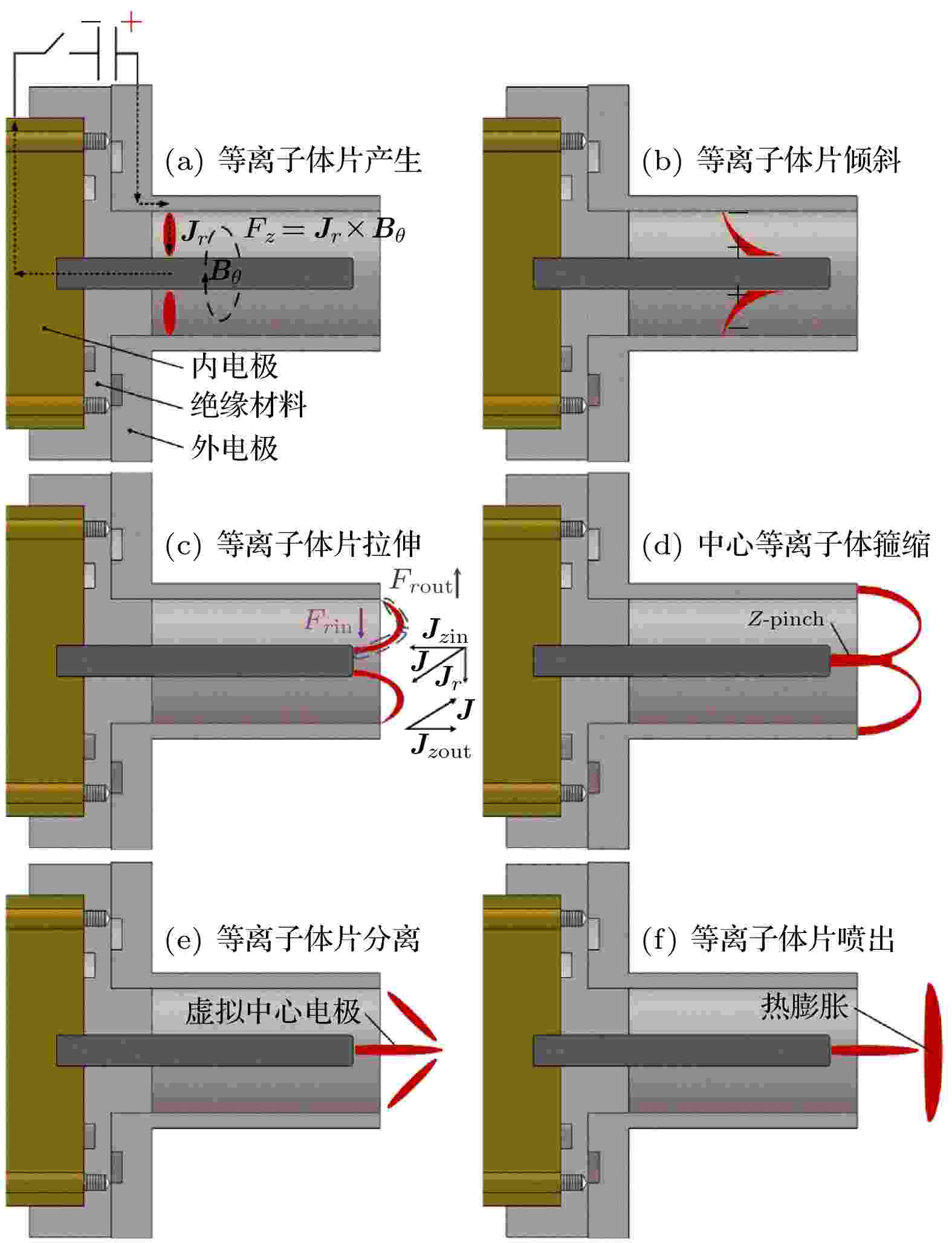 图 5 短外电极同轴枪放电中的等离子体片发展过程
图 5 短外电极同轴枪放电中的等离子体片发展过程Figure5. Development of plasma sheet during discharge in a coaxial gun with short outer electrode.
而对于长外电极, 当等离子体片运动至内电极的末端时, 由于外电极的延长, 等离子体片被拉伸为逆时针旋转90o的“八”字型(见图6(a)), 因此将只会产生指向中心的径向洛伦兹力Frin而不会受到Frout的作用. 而在箍缩效应发生后, 中心等离子体温度、电子密度的升高导致其抗拉扯的能力显著提升, 能够保证剩余的等离子体通过其后继续沿轴向传播, 直至因等离子体片拉伸和轴向电流分量Jzin而引起下一次箍缩效应的发生(见图6(b)), 在往复的箍缩、前进过程中等离子体片在枪内得到了进一步地加速, 最终发生分离并从枪口喷出.
 图 6 长外电极同轴枪放电中的等离子体片发展过程
图 6 长外电极同轴枪放电中的等离子体片发展过程Figure6. Development of plasma sheet during discharge in a coaxial gun with long outer electrode.
2
3.4.等离子体电子密度
图7所示为不同长度外电极中等离子体电子密度随充电电压的变化, 测量位置为距同轴电极喷口75 mm轴线位置处(B点). 与等离子体速度的对比结果相反, 在所有充电电压下短外电极同轴枪放电中的电子密度均明显高于长外电极, 这也和光电流信号以及高速相机图像中得到的光强结果一致. 外电极的延长, 虽然使等离子体在枪内获得了更长的加速时间, 提高了喷出等离子体的速度, 但也不可避免地延长了其与外电极内壁的作用时间, 增加了等离子体的碰撞复合损失, 从而引起电子密度的降低. 此外, 与短外电极相比, 在长外电极同轴枪放电中需要更长的等离子体柱来与外电极形成长度上的匹配, 以延长等离子体的加速时间, 这一方面提高了主回路对其的供能, 使得等离子体在延长段的加速中能够电离更多的中性气体; 另一方面则导致枪内更多的等离子体被箍缩至等离子体柱中, 造成了带电粒子的大量损耗. 因此, 长短外电极同轴枪放电中等离子体电子密度的差异是多种机制共同作用的结果.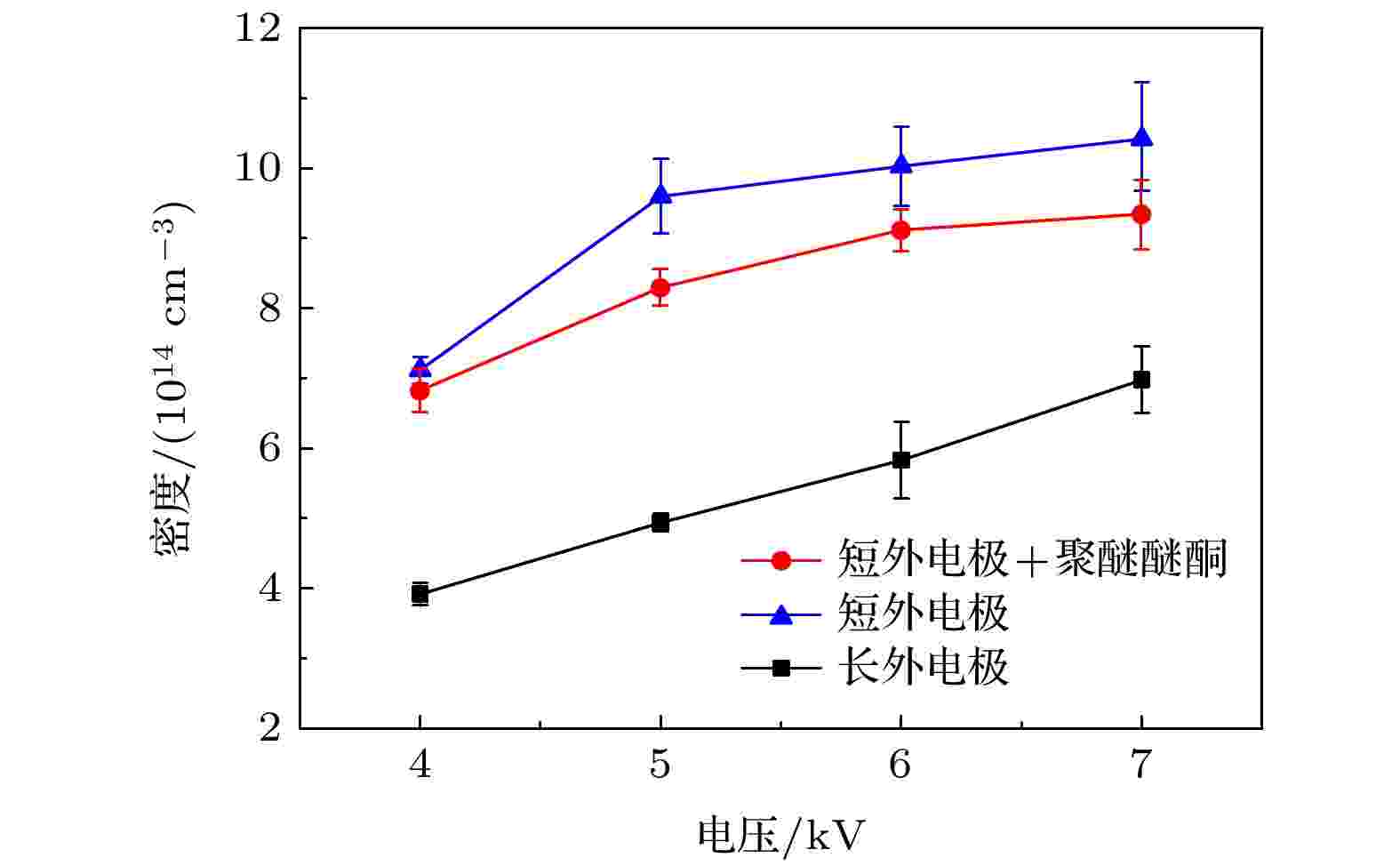 图 7 同轴枪在气压为10 Pa的放电条件下, 电子密度随充电电压的变化
图 7 同轴枪在气压为10 Pa的放电条件下, 电子密度随充电电压的变化Figure7. The variation of electron density with the charging voltage of the coaxial gun at 10 Pa.
为进一步澄清以上三种机制对等离子体电子密度的影响规律, 仍然利用3.2中短外电极与聚醚醚酮的组合, 来与长短外电极同轴枪中的结果进行对比. 如图7所示, 短外电极与聚醚醚酮组合中所得到的电子密度介于短外电极与长外电极之间, 这说明与主回路供能增加所提高的电子密度相比, 等离子体柱加长所带来带电粒子的损耗仍旧占据着主导地位, 所以短外电极与聚醚醚酮组合中的等离子体电子密度要比长外电极的高. 而比较不同电压下的具体数值后发现, 与长外电极相比, 短外电极与聚醚醚酮组合同轴枪中的电子密度显然更为接近短外电极中的结果, 这说明与复合损失比, 等离子体柱加长对电子密度降低的贡献更大. 综合以上分析可知, 由长外电极所导致枪内等离子体柱的延长是引起等离子体电子密度及发光强度显著降低的最主要原因.
2
3.5.等离子体输运准直性的对比
除了以上讨论的几项等离子体参数外, 喷出射流的准直性同样是一个对等离子体输运衰减特性及实际应用都非常关键的衡量指标. 图8为长曝光时间下不同外电极长度同轴枪的放电图像. 与短外电极时的情况相比, 在长外电极同轴枪放电时所产生的等离子体虽然发光强度更低, 但喷出后射流的扩散角也更小, 且能够传播更远的距离. 图 8 数码相机拍摄的不同外电极长度条件下的放电照片 (a) 短外电极; (b) 长外电极. 气压为10 Pa, 充电电压为7 kV, 曝光时间为1 s
图 8 数码相机拍摄的不同外电极长度条件下的放电照片 (a) 短外电极; (b) 长外电极. 气压为10 Pa, 充电电压为7 kV, 曝光时间为1 sFigure8. Digital camera photographs of discharge in a coaxial gun with (a) short and (b) long outer electrode. P = 10 Pa, V = 7 kV, the exposure time is 1 s.
为了能够更加准确地定量分析放电参数与等离子体准直性的关系, 基于图像识别中的边缘检测技术, 利用自编译的MATLAB程序计算得出了不同外电极长度下射流扩散角随充电电压的变化. 由于边缘检测后射流的上下边沿均由以像素点为基本单位的折线所组成, 因此其扩散角D的计算公式可表示为


如图9所示, 与长外电极中的结果相比, 不同电压下短外电极中的扩散角都明显更大, 在4 kV时其数值能达到前者的近1.5倍. 而随着电压的逐步升高, 长短外电极中的扩散角亦随之增大, 且两者之间的差值也会相应增加, 这说明在更高电压时长外电极对等离子体射流扩散的抑制效应也会更加明显.
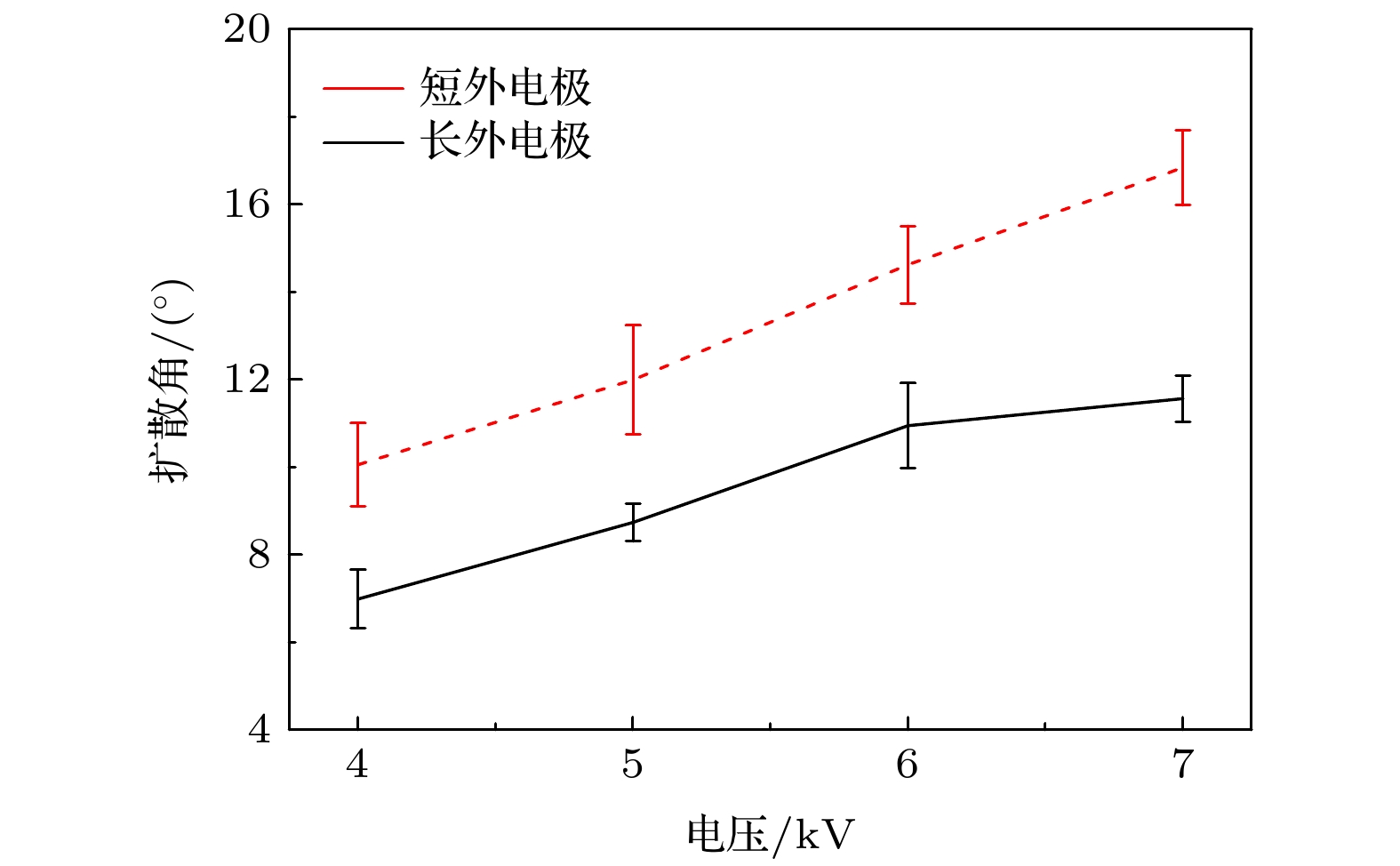 图 9 同轴枪在气压为10 Pa的放电条件下, 扩散角随充电电压的变化
图 9 同轴枪在气压为10 Pa的放电条件下, 扩散角随充电电压的变化Figure9. The variation of diffusion angles with the charging voltage of the coaxial gun at 10 Pa.
分析后认为, 等离子体射流的准直性是受多种因素耦合控制影响的. 一是等离子体的轴向动能, 其主要由等离子体轴向速度与电子密度两个参数所共同决定. 放电前真空腔室内的气压保持为10 Pa, 离开枪口后等离子体还会不停地电离前方的中性气体, 将轴向动能转化为电磁能与热能, 因此等离子体的轴向速度越大、电子密度越高, 射流的传播距离就越远. 对比于短外电极, 在长外电极中等离子体的速度增加与电子密度减少的倍率大致相当, 但由于轴向动能与等离子体速度的平方成正比, 故在长外电极中等离子体能够传播更远的距离. 二是等离子体的径向扩散, 它主要受等离子体电子密度及径向洛伦兹力的影响. 脱离外电极的几何约束后, 喷出等离子体会因为密度梯度及热膨胀而迅速扩散, 导致输运过程中能量密度的快速下降, 因此等离子体的电子密度越高, 其扩散角越大, 传播距离越短. 而在3.3中已经提及, 在等离子体柱出现的同时, 短外电极中剩余的等离子体会受到指向外侧的径向洛伦兹力Frout, 进一步加剧射流喷出后的径向扩散, 所以我们才能从其放电图像中观察到更大的扩散角. 而随着充电电压的增加, 等离子体的速度、电子密度以及径向洛伦兹力均会增加, 最终引起了等离子体扩散角与传播距离的同时增加.
受限于实验条件, 我们无法更加深入地澄清等离子体输运衰减特性的影响规律. 但本文中所实现的等离子体参数还远未达到工程应用的标准, 如何在有效地提高等离子体性能的同时通过有效的参数调控来抑制等离子体喷出后的扩散和衰减亦非常关键, 这也是我们后续的研究重点. 仅基于目前的实验结果, 高轴向速度、高电子密度以及相对较长的外电极更有利于高准直性等离子体射流的产生.
